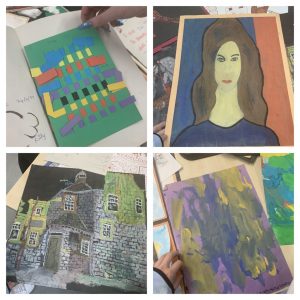For our final dance workshop, we combined all our routines together to make one big collaborative performance. I was slightly nervous as I knew our final performance was being recorded. This made me feel slightly anxious as I was still struggling to remember the sequence of the dance. However, I was put at ease when we were given time to go into out groups and go over our routines. Watching the recording back, I was really proud of myself as dancing is completely out of my comfort zone. I also realised that the most important thing is to just have fun with it and to not take yourself too seriously. After watching the recording, we then gave ourselves two stars and a wish. This allowed me to reflect on my time in dance and to see how far I have come since the first session. In the first session the thought of doing a dance routine in front of the whole class would have really terrified me. I was really proud of myself as I was able to dance confidently in front of my peers and was able to turn something I used to dread into something that was fun. One thing I would work on for next time would be timing. This would come with practise and repetition.
This exercise also highlighted that the teacher does not always need to take leadership and that young people themselves need to be encouraged to take creative ownership of their own performances.

The value of expressive arts such as dance cannot be underestimated. It has the ability to stimulate artistic processes of creating, performing and critical analysis. It requires students to read symbols, develop nonverbal communication skills and exploring ideas together (NDEO, n.d). Dance education also encourages social relationships. In an evaluation of Dancing Classrooms in New York City, ninety-five percent of teachers said dancing together resulted in improved cooperation and collaboration between students (Robinson and Aronica, 2018).
In this weeks music workshop we were learning how to play the ukulele. I had never played the ukulele however, after todays session I managed to play five different cords and learned to play along to different music such as Last Christmas. I thought playing along to famous music was a good idea as the pupils would already know what the music sounds like and what they should expect to hear when they are playing the instruments. I also thought this would be a good idea to introduce a couple months before christmas. The pupils would have time to learn various christmas songs and put on a christmas performance for other pupils, teachers and parents.
Learning a musical instrument also has many benefits such as-
- Increases memory skills
- Teaches perseverance
- Improves coordination
- Improves math and reading skills
- Creates responsibility
- Exposes the student to culture and history
- Nurtures self-expressions
- Improves listening and social skills
I have enjoyed pushing myself outside of my comfort zone and testing myself to be more free. These sessions have allowed me to bring my creative thoughts to life through dance and music.
The benefits of the creative arts in an early childhood education have been well documented. It provides an outlet for young children to explore and gain control over their emotions (Chen, 2016). I am excited to in the future incorporate all my learning into the classroom.
References
Chen, S. (2016). The Importance of Creative Arts in Early Childhood Education. [online] Novak Djokovic Foundation. Available at: https://novakdjokovicfoundation.org/importance-creative-arts-ece/ [Accessed 6 Dec. 2019].
Curriculum for Excellence: Expressive arts Experiences and outcomes. (n.d.). [ebook] Scotland: Education Scotland, pp.1,5. Available at: https://education.gov.scot/Documents/expressive-arts-eo.pdf [Accessed 11 Dec. 2019].
Ndeo.org. (n.d.). About Dance Education – National Dance Education Organization. [online] Available at: https://www.ndeo.org/content.aspx?page_id=22&club_id=893257&module_id=194704 [Accessed 7 Dec. 2019].
Robinson, S. and Aronica, L. (2018). Why dance is just as important as math in school. [online] ideas.ted.com. Available at: https://ideas.ted.com/why-dance-is-just-as-important-as-math-in-school/ [Accessed 5 Dec. 2019].



















